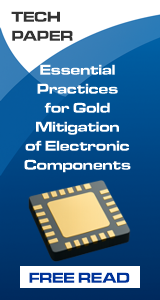|

|
A Method to Investigate PCB Supplier Rework Processes and Best Practices
Analysis Lab |
|
Authored By:Hailey Jordan, Wade Goldman P.E., Curtis Leonard The Charles Stark Draper Laboratory, Inc., Cambridge, Massachusetts Edward Arthur Raytheon Company, Space and Airborne Systems, El Segundo, California SummarySeveral incidents occurred that prompted a team to investigate Printed Circuit Board (PCB) supplier best practices and rework procedures. Two of the more prominent incidents that occurred and precipitated the best practice and rework investigation include: 1) the stripping of cured soldermask/legend which led to weave exposure and the scrap of 100 affected PCBs, and 2) evidence of a foreign inclusion that is believed to have been a catalyst for Conductive Anodic Filament (CAF). An investigation into the root cause of the exposed weave PCB manufacturing lot (item #1 above) determined that a caustic rework procedure was responsible for the erosion of the buttercoat leading to exposed glass fibers on the surface of the boards. Additionally, it was derived that Foreign Object Debris (FOD) played a catalytic role leading to CAF resulting in a short on a delivered Printed Circuit Assembly (PCA) (item #2 above). FOD was believed to have been created during the manufacturing process. As a result of the two events above, the team concluded it was in the programs best interest to visit each program qualified PCB supplier and conduct site surveys into the suppliers rework best practices. The PCB suppliers site survey had three main objectives: 1) identify and document all potential rework scenarios, 2) better understand supplier FOD program and look for opportunities for improvement and 3) once all potential reworks are understood and documented, identify potential rework procedures that could be detrimental to the program and take steps to mitigate their occurrence. Through the interview of many PCB manufacturing personnel in four manufacturing locations, the PCB rework investigation team documented 60 possible rework scenarios and assessed each one’s relative risk of occurring and potential impact to PCB quality and reliability using a weighted formula based on several factors. This paper provides a structured overview of the team’s methodology to investigate PCB supplier rework processes, including identifying rework procedures that have potential implications to PCB functionality, and the approach to weighting reworks to determine the associated level of risk. ConclusionsA methodical approach was used to assess PCB manufacturers rework operations. After thorough investigations at each manufacturing location, the team worked with one supplier to develop a matrix of all potential rework scenarios. The matrix used four weighted elements to determine the level of risk associated with each rework process. The matrix was then used to identify the rework processes that the team deemed most problematic and had the potential to negatively impact PCB quality and reliability. Once the investigation was complete and the rework matrix finalized, all undesired rework processes identified during the investigation were incorporated into program documentation as restricted rework processes with the intent of reducing future system failures and improving overall PCA quality. Initially Published in the SMTA Proceedings |
|
Comments
|
|
|
|

|


